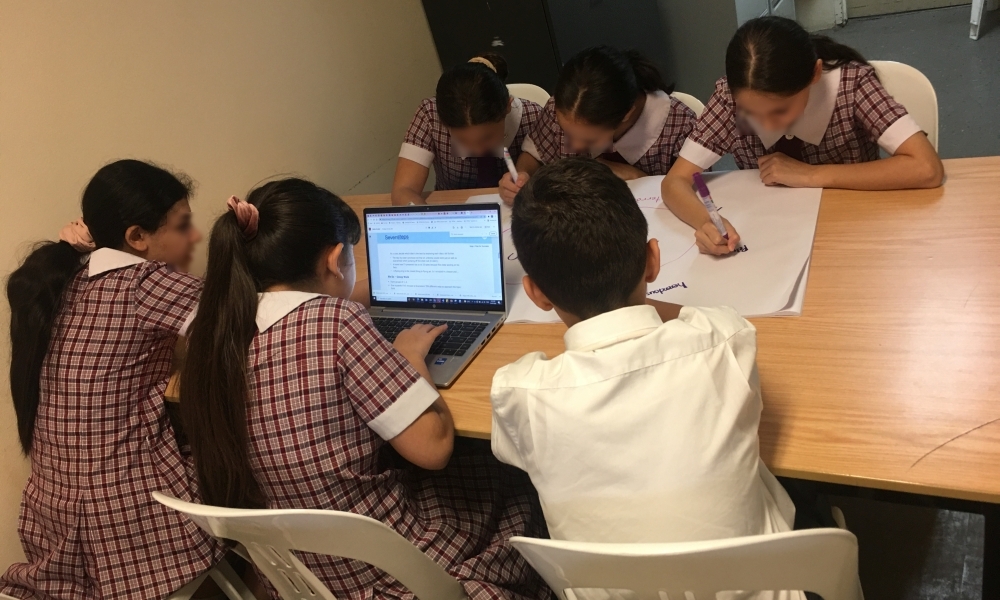Readers often get in touch with Teacher to share how their school is making a difference to student outcomes. New South Wales educator Mary Semaan contacted us recently to talk about how the teaching and leadership team at Al Sadiq College has been working to improve primary students’ writing skills.
‘The dream was not only to reach state level in NAPLAN writing (the national basic skills assessment in Australia), but to impart a love for writing on the students, giving them the tools to be creative writers, whilst enjoying the writing process,’ she explains.
Semaan is Head of Primary and Head of Learning Support/Enrichment (K-12) at the two-campus school in South Western Sydney, where all 735 students are from non-English speaking backgrounds.
Sharing a vision for improvement
When she arrived at the school in 2018, the focus was on improving reading and writing in the junior school, with a particular emphasis on students in Kindergarten to Year 3. ‘At the beginning of 2019, writing pre-test results showed lack of creativity, poor grammatical concepts and limited vocabulary,’ she recalls. ‘Less than 25 per cent of students across Years 3-6 were able to compose a “satisfactory” piece of writing using basic narrative or persuasive structure; those that could, did so with assistance.’
That year she shared her vision to improve reading and writing standards across Years 3-6. ‘With the help of Primary leaders, Diana Usanmaz (Years 4-6 Head of Campus, Greenacre Primary) and Courtney Fenton (K-3 Head of Campus, Yagoona), along with a very determined team of teachers, we set out to invest in evidence-based practices with the aim to raise standards.’
Semaan wanted to find an approach that would fit with the school’s explicit teaching model, alongside existing programs targeting phonics and spelling, and help students of all abilities. She remembered seeing a presentation a few years earlier about the Seven Steps writing program, but was unsure it would be suitable for Al Sadiq, given the range of student ability levels. ‘The range included learning support students, who received support for both reading and writing, and enrichment students who were working slightly above the other students in writing.
‘However, implementing the Seven Steps program gave both the teachers and students an approach to writing that could be taught explicitly, using a “chunking” method. Each component was taught separately – with modelling from teachers – and students were able to effectively master each part before putting it all together and composing a complete piece of writing.’
Years 5 and 6 began using the program in 2019, with the aim to see some improvement in the Year 5 and 7 NAPLAN results. ‘The students mastered Sizzling Starts quickly and enjoyed their newfound method of starting stories off “at the action”.’ After seeing the improvement in students, the program was introduced into Year 3 and 4 in 2020, with a further focus on building vocabulary, creativity and descriptive language.
Taking a structured approach
Semaan says having a structured approach – drawing on knowledge from previous lessons, sharing ideas, modelling, guiding, collaborating and then writing independently – was a massive turning point for students and teachers.
Teachers are now reading snippets of different books, such as Harry Potter, and asking students to think about how the author has hooked in readers and kept them interested. ‘It is amazing because the kids are saying, “Oh yeah, this actually didn't start with once upon a time, it started where the action was…”.’
Semaan says as students of all abilities started to make good progress, she reflected on her own teaching and leadership journey. ‘I was thinking that this is the way to go… taking the explicit teaching that I believe so much in and putting it together with opportunities for kids to show their creativity and get the fun into learning, this was getting results. When explaining it to teachers, Semaan and the Primary leaders would say, ‘we’re not just doing it for compliance, we’re doing it for best practice’.
Connections to students’ everyday lives
Semaan says during the teaching process it was important for students to make as many connections to their everyday lives as possible. ‘So, if that means walking out of the classroom and seeing a puddle – “think of a sizzling start, if someone you know falls over in the puddle, think about the raindrops coming down and use your five senses to describe them”.’
At the same time, teachers are broadening students’ vocabulary and trying to expose them to as many different things as possible to act as a stimulus for their writing. ‘We show them videos, we look at books, we look at pictures – a lot of visuals. For example, we’ll say, “let's look at this Australian rainforest, describe it to me. What type of creatures would live there?” If they wanted to write about the snow, they’d have to research it … it has actually opened up a whole new world for the kids.’
Impact on student writing outcomes
Semaan says this renewed enjoyment of and passion for writing resulted in a marked improvement in structure, a range of descriptive language, extended vocabulary and a greater focus on reader engagement. ‘What once seemed almost impossible, had become an enjoyable process. Students have developed a greater confidence in their abilities and are keen to further develop their skills.’
In 2020 and 2021 enrichment students in Years 6 and 7 achieved their dream of entering an entire book in the ‘Write a Book in a Day’ competition, to raise money for the Kids Cancer Project. The stories were engaging and included a range of writing techniques.
Results in both reading and writing have improved. Semaan says Year 3 and Year 5 students achieved impressive NAPLAN results in 2021, with 90 per cent of students achieving in the top two bands in writing. This year, students in Years 2-6 are using the Seven Steps program.
‘We still have a long way to go, but our kids have done so well with the program and I’m so excited to be able to share our story with Teacher. When I told the kids I was going to be speaking to you today they were so thrilled! We've got an amazing team of teachers across K-6, they are brilliant and we're all working together, we have the same vision. We believe in the kids a lot and we’re reaping the benefits now of this approach.’
What strategies and materials do you use to support your teaching of narrative writing and to encourage students to be more creative in their storytelling? How do you link learning to students’ everyday lives and experiences?



